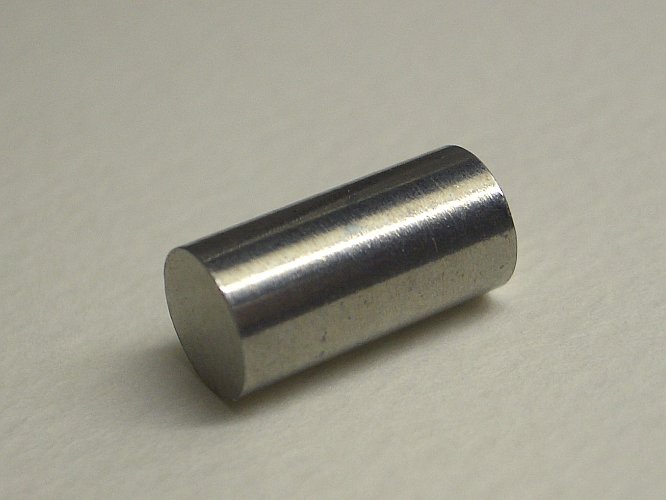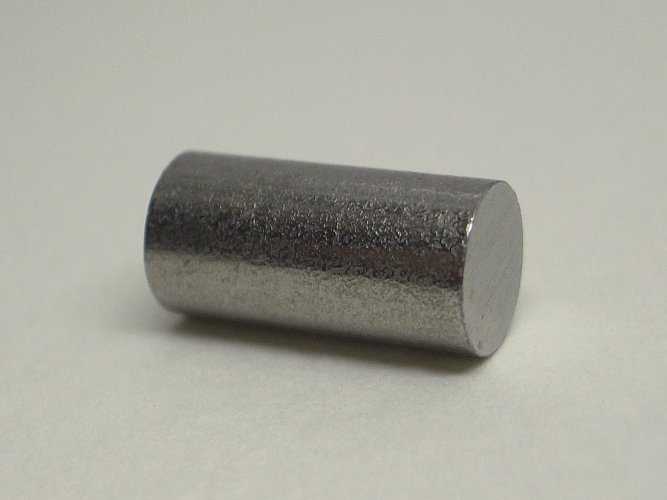


Molybdenum and tungsten (wolfram)
Molybdenum and tungsten are lustrous silvery metals. Chemically speaking, these two metals resemble each other very much, while they differ quite a lot from their lighter congener chromium. The pictures below show samples of equal dimensions of the metal, the left is a sample of 4 grams of molybdenum, the right is a sample of 8 grams of tungsten.


The metals are quite inert, being more inert than chromium. They are attacked only slowly by mineral acids. Both metals have high melting points, but tungsten (wolfram) is used for this purpose exclusively. Its melting point is 3422 °C, which makes it suitable for lamps. The well-known tungsten-bulbs contain a thin wire or spiral of tungsten metal, which is heated to around 3000 degrees and which emits light at this temperature.
Both metals can be obtained from eBay on a regular basis. These metals then are available as rods or lumps. Tungsten also is available in the form of fine wires in lamps. This, however, is quite an expensive source of tungsten, because of the small weight of metal per bulb. Having the metals at hand is not necessary for the home lab. The bulk metals are very hard to make into fine filings or powder and as such are not really suitable for chemistry experiments.
![]()
Like the element chromium, molybdenum and tungsten also can reach the group oxidation state +6 in their compounds. In fact, this high oxidation state is much more stable for molybdenum and tungsten than for chromium.
The compounds in the +6 oxidation state are no strong oxidizing agents, like the chromium counterparts. However, they can be reduced to a lower oxidation state, all the way down to oxidation state +3. Where chromium has a tendency to have compounds of a single oxidation state, the compounds of molybdenum and tungsten easily can have the metal in multiple oxidation states (e.g. mixed +5 and +6) in one ion. The multiple oxidation state compounds have a very strong color, usually blue to black. These compounds are sometimes referred to as the 'molybdenum blues' or 'tungsten blues'.
Another remarkable property of these two metals is their tendency to form very complex poly-anions, which can contain many molybdenum or tungsten atoms, surrounded by even more oxo-groups, hydroxo-groups or aqua-groups.
For the general public, the following compounds of these metals are available:
- molybdenum trioxide, MoO3
- tungsten trioxide, WO3
- ammonium 'molybdate', (NH4)6Mo7O24·4H2O
- sodium tungstate dihydrate, Na2WO4·2H2O
![]() Molybdenum trioxide is a white to light grayish/blue powder, available from
ceramics and pottery suppliers. The light grayish/blue color may be due to a
slight oxygen deficiency in the commercial product, its actual formula being MoO3-x,
instead of MoO3, with x being a positive number close to 0.
Molybdenum trioxide hardly dissolves in water, but it easily dissolves in
alkalies without heating and then can be acidified without the formation of a
precipitate. Molybdenum trioxide is an interesting and affordable compound,
which allows one to study molybdenum chemistry without too much trouble.
Molybdenum trioxide is a white to light grayish/blue powder, available from
ceramics and pottery suppliers. The light grayish/blue color may be due to a
slight oxygen deficiency in the commercial product, its actual formula being MoO3-x,
instead of MoO3, with x being a positive number close to 0.
Molybdenum trioxide hardly dissolves in water, but it easily dissolves in
alkalies without heating and then can be acidified without the formation of a
precipitate. Molybdenum trioxide is an interesting and affordable compound,
which allows one to study molybdenum chemistry without too much trouble.
![]() Tungsten trioxide is a bright yellow powder, available from
some eBay sellers. Tungsten trioxide does not dissolve in water, but more easily
in alkaline solutions. It does not dissolve as easily as molybdenum trioxide,
but with some heating it can be dissolved in dilute solutions of sodium
hydroxide. Such a solution then can be used for further experiments with
tungsten salts.
Tungsten trioxide is a bright yellow powder, available from
some eBay sellers. Tungsten trioxide does not dissolve in water, but more easily
in alkaline solutions. It does not dissolve as easily as molybdenum trioxide,
but with some heating it can be dissolved in dilute solutions of sodium
hydroxide. Such a solution then can be used for further experiments with
tungsten salts.
![]() Ammonium molybdate is a white crystalline solid, which can be obtained from
chemical supply houses and from some well equipped drugstores. It dissolves in
water easily. The main use of this chemical is as reagent for phosphate ion.
With phosphate ion, a deep yellow compound is formed, which slowly precipitates
from the solution as ammonium molybdophosphate. This compound also is
interesting, but when molybdenum trioxide is available, then there is no real
reason to purchase this compound.
Ammonium molybdate is a white crystalline solid, which can be obtained from
chemical supply houses and from some well equipped drugstores. It dissolves in
water easily. The main use of this chemical is as reagent for phosphate ion.
With phosphate ion, a deep yellow compound is formed, which slowly precipitates
from the solution as ammonium molybdophosphate. This compound also is
interesting, but when molybdenum trioxide is available, then there is no real
reason to purchase this compound.
![]() Sodium tungstate is a white crystalline solid, which can be ordered from some
photography raw chemical suppliers and from chemical supply houses. This
compound also easily dissolves in water. Sodium tungstate is a fairly expensive
chemical, but it can be used for quite some interesting experiments. However, if
tungsten trioxide is available, then there is no need to buy sodium tungstate.
It is not the compound to start with in a home lab, but when one wants to
experiment with tungsten compounds, then this is the most convenient compound to start with.
Sodium tungstate is a white crystalline solid, which can be ordered from some
photography raw chemical suppliers and from chemical supply houses. This
compound also easily dissolves in water. Sodium tungstate is a fairly expensive
chemical, but it can be used for quite some interesting experiments. However, if
tungsten trioxide is available, then there is no need to buy sodium tungstate.
It is not the compound to start with in a home lab, but when one wants to
experiment with tungsten compounds, then this is the most convenient compound to start with.